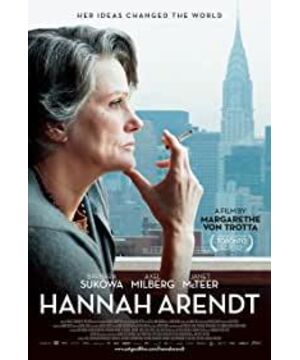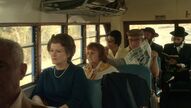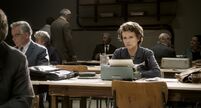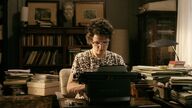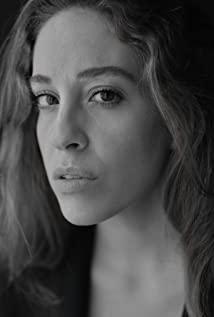Mark Lilla
Hannah Arendt
a film by Margarethe von Trotta
Hannah Arendt: Ihr Denken veränderte die Welt [Hannah Arendt: Her Thought Changed the World]
edited by Martin Wiebel, with a foreword by Franziska Augstein
Munich: Piper, 252 pp., €9.99 (paper)
1.
In The Drowned and the Saved, Primo Levi's final book on his experiences at Auschwitz, he makes a wise remark about the difficulty of rendering judgment on history. The historian is pulled in two directions. He is obliged to gather and take into account all relevant material and perspectives; but he is also obliged to render the mass of material into a coherent object of thought and judgment:
Without a profound simplification the world around us would be an infinite, undefined tangle that would defy our ability to orient ourselves and decide upon our actions…. We are compelled to reduce the knowable to a schema.
lilla_1-112113-250.jpg Hannah Arendt Bluecher Literary Trust
Hannah Arendt and Mary McCarthy, Sicily, 1971
Satisfying both imperatives is difficult under any circumstances, and with certain events may seem impossible. The Holocaust is one of those. Every advance in research that adds a new complication to our understanding of what happened on the Nazi side, or on the victims', can potentially threaten our moral clarity about why it happened, obscuring the reality and fundamental inexplicability of anti-Semitic eliminationism. This is why Holocaust studies seems to swing back and forth with steady regularity, now trying to render justice to particulars (German soldiers as “ ordinary men"), now trying to restore moral coherence (Hitler's “willing executioners”).
Among Primo Levi's virtues as a writer on the Holocaust was his skill at finding the point of historical and moral equipoise, most remarkably in his famous chapter “The Gray Zone” in The Drowned and the Saved. It is not easy reading. Besides recounting the horrifying dilemmas and unspeakable cruelties imposed by the Nazis on their victims, he also gives an unvarnished account of the cruelties that privileged prisoners visited on weaker ones, and the compromises, large and small, some made to maintain those privileges and their lives. He describes how the struggle for prestige and recognition, inevitable in any human grouping, manifested itself even in the camps, producing “obscene or pathetic figures…whom it is indispensable to know if we want to know the human species.”
Levi tells the story of Chaim Rumkowski, the vain, dictatorial Jewish elder of the Łódź ghetto who printed stamps with his portrait on them, commissioned hymns celebrating his greatness, and surveyed his domain from a horse-drawn carriage. Stories like these that others have told and others still have wished to bury are unwelcome complications. But Levi tells them without ever letting the reader lose sight of the clear, simple moral reality in which they took place. Yes, “we are all mirrored in Rumkowski, his ambiguity is ours , it is our second nature, we hybrids molded from clay and spirit." But “I do not know, and it does not much interest me to know, whether in my depths there lurks a murderer, but I do know that I was a guiltless victim and I was not a murderer."
Two recent films by major European directors show just how difficult this point of equipoise is to find and maintain when dealing with the Final Solution. Margarethe von Trotta's Hannah Arendt is a well-acted biopic on the controversy surrounding Arendt's Eichmann in Jerusalem and its place in her intellectual and personal life. Claude Lanzmann's The Last of the Unjust is a documentary about Benjamin Murmelstein, the last Jewish elder of the Theresienstadt concentration camp, who was considered a traitor and Nazi collaborator by many of the camp's inmates, and was the only elder in the entire system to have survived the war. The directors have very different styles and ambitions, which they have realized with very different degrees of success. But neither has managed to replicate Levi's achievement.
2.
Hannah Arendt's Eichmann in Jerusalem was published fifty years ago, first as a series of articles in The New Yorker and then, a few months later, as a book. It's hard to think of another work capable of setting off ferocious polemics a half-century after its publication. Research into the Nazi regime, its place in the history of anti-Semitism, the gestation of the Final Solution, and the functioning of the extermination machine has advanced well beyond Arendt, providing better answers to the questions she was among the first to address.
In any normal field of historical research one would expect an early seminal work to receive recognition and a fair assessment, even if it now seems misguided. Yet that is only now starting to happen within the history profession, in works like Deborah Lipstadt's judicious, accessible survey The Eichmann Trial (2011). As the strong reactions to von Trotta's film indicate, though, the Arendt–Eichmann psychodrama continues in the wider world. Now as then critics focus on two arguments Arendt made, and on the fact that she made them in the same book.
The first, and better known, was that although Adolf Eichmann was taken by many at the time to be the mastermind of the Final Solution, the trial revealed a weak, clueless, cliché-spewing bureaucrat who, according to Arendt, “never realized what he was doing," an everyman caught up in an evolving bureaucratic program that began with forced emigration and only later ended with extermination as its goal. That one “cannot extract any diabolical or demonic profundity from Eichmann” did not, in her eyes, reduce his culpability. From the start Arendt defended his capture, trial, and execution, which were not universally applauded then, even by some prominent Jews and Jewish organizations.1 This her critics forget, or choose to forget. What they remember is that she portrayed Eichmann as a risible clown, not radically evil,and shifted attention from anti-Semitism to the faceless system in which he worked.
Had Arendt written a book on what she called “the strange interdependence of thoughtlessness and evil” in modern bureaucratic society, it would have been read as a supplement, and partial revision, of what she said about “radical evil” in The Origins of Totalitarianism . No one would have been offended. But in Eichmann she made the unwise choice of hanging her thesis on the logistical “genius” of the Holocaust, whose character she tried to infer from court documents and a few glimpses of him in the bullet-proof glass docket in Jerusalem.
To make matters worse, in the same book Arendt raised the sensitive issue of the part that Jewish leaders played in the humiliation and eventual extermination of their own people. These included the heads of the urban Jewish community organizations that facilitated forced emigration, expropriations, arrests , and deportations; and the heads of the Jewish councils the Nazis formed in the ghettos and camps to keep the inmate population in line. These men were understandably feared and resented even if they carried out their duties nobly, while those who abused their power, like Rumkowski, were loathed by survivors, who circulated disturbing stories about them after the war.
There was little public awareness of these figures, though, until the Kasztner affair broke in the mid-1950s. Rudolph Kasztner was at that time an Israeli official, but during the war he had worked for a group in Budapest that helped European Jews get to Hungary, which was then unoccupied, and then tried to get them out after the German invasion in 1944. As thousands of Jews were being shipped daily to the gas chambers, Kasztner and his group entered into negotiations with the Nazis to see if some could be saved. After various plans to save large numbers failed, Kasztner persuaded Eichmann to accept a cash ransom and allow 1,600 Hungarian Jews to leave for Switzerland, many of them wealthy people who paid their way and others from his hometown and family.
In 1953 a muckraking Israeli journalist claimed that Kasztner had secretly promised the Nazis not to tell other Jews about Auschwitz, trading a few lives for hundreds of thousands. Kastzner sued for libel but lost his case when it was revealed that he had written exculpatory letters to war tribunals for Nazis he had worked with in Hungary. Before his appeal could be heard Kastzner was assassinated in front of his Tel Aviv home, in circumstances that remain obscure to this day. He was posthumously acquitted.
The cooperation of Jewish leaders and organizations with the Nazi hierarchy became more widely known through the Eichmann trial and the publication in 1961 of Raoul Hilberg's monumental study, The Destruction of the European Jews, which Arendt relied on heavily without adequate attribution. Though Hilberg's book is widely revered today, he was just as widely attacked after its publication by Jewish organizations and publications for emphasizing the leaders' cooperation and the rarity of active resistance, which he attributed to habits of appeasement developed over centuries of persecution, an argument Bruno Bettelheim echoed a year later in his controversial article “Freedom From Ghetto Thinking.”
So Hannah Arendt was not betraying any secrets when she discussed these issues in a scant dozen pages of her book; she was reporting on what came up at the trial and found herself in the middle of an ongoing, and very sensitive, polemic. But exercising her gift for the offending phrase, she also portrayed the Jewish leaders as self-deceived functionaries who “enjoyed their new power,” and she termed their actions “undoubtedly the darkest chapter of the whole dark story.”
Perhaps by “dark” all she meant was especially awful and a sign of “the totality of the moral collapse the Nazis caused…not only among the persecutors but also among the victims.” But pulled out of context her phrases made it appear that she was equating doomed Jewish leaders with the “thoughtless” Eichmann, or even judging them more severely. In any case, the whole discussion, a small fraction of the book, was psychologically obtuse and made her monstrous in the eyes of many.
And the response was ferocious, in Europe and the United States. Her now former friend Gershom Scholem sent Arendt a public letter complaining, rightly, about her “flippancy” and lack of moral imagination when discussing the Jewish leaders, and declared her to be lacking in “love of the Jewish people.” Siegfried Moses, a former friend and recently retired Israeli official, sent a letter “declaring war” on her and got the Council of Jews in Germany to publish a condemnation even before serialization of her book in The New Yorker was complete. (He then flew to Switzerland to try to persuade her to abandon the book project altogether.) The American Anti-Defamation League sent out a pamphlet titled Arendt Nonsense to book reviewers and rabbis across the country, urging them to condemn her and the New Yorker articles for giving succor to anti-Semites.
And in the New York intellectual circles that had become her adoptive home, she became the focus of angry attention from friends who once admired her. At the controversy's peak Dissent magazine organized a forum to discuss the work and invited Arendt (she declined), Hilberg , and their critics. Hundreds showed up and the evening quickly descended into a series of denunciations of Arendt, who was defended briefly only by Alfred Kazin, Daniel Bell, and a few others. Only when President Kennedy was assassinated in November did she finally escape the spotlight.
3.
This messy episode is the surprising focus of Margarethe von Trotta's much-discussed new film. As von Trotta tells it, her original intention was to trace the arc of Arendt's life as a whole, much as she did with Rosa Luxemburg in her award-winning biopic Rosa Luxemburg (1986), but found the material too unwieldy. And so she choose to limit herself to Arendt's life in New York. As she says in the short German book on the film edited by Martin Wiebel, what interested her was not the ins and outs of the Eichmann case but rather Hannah and her friends. This seems an odd choice for a movie but makes sense in view of von Trotta's other work. Her specialty is didactic feminist buddy movies—in fact, one might say that she's been making the same film throughout her career. The story usually involves two women, either friends or sisters,one of them a visionary or pillar of strength, the other a jejune admirer, and follows the evolution of their relationship against a political backdrop.
In her first solo directed work, The Second Awakening of Christa Klages (1978), a woman holds up a bank to save the child care center she works at, then gets help from a soldier's wife who becomes her lover and goes into hiding with her . They end up in a rural Portuguese cooperative getting their consciousness raised, are expelled for lesbianism, and have other adventures before it all ends badly. Marianne and Juliane (1981) uses as its model the life of Gudrun Ensslin, a founding member of the Baader-Meinhof gang who committed suicide in her cell in 1977; the story follows the Gudrun character and her sister as their relationship develops from alienation to reconciliation, and ends in a display of sisterly solidarity that reaches beyond the grave.
lilla_2-112113.jpg Bettmann/Corbis
Adolf Eichmann with Israeli police at his trial in Jerusalem, May 1962
Von Trotta's Vision (1991), which treats the life of the medieval mystic Hildegard von Bingen, is the most transparent example of the type. It portrays a courageous, enlightened woman prone to epiphanies who stays true to her visions and resists the church's attempts to silence her. Along the way she develops a deep if unequal friendship with another nun, then another, provoking jealousy and misunderstanding, though it all works out in the end. She dies revered by those around her, though not by the powers that be.
And this, more or less, is the story of Hannah Arendt. The film opens with a jovial Arendt (Barbara Sukowa) in conversation with her best friend Mary McCarthy (Janet McTeer), who in the movie is reduced to a hyperactive sidekick. They discuss men, they discuss love, they have a cocktail party with Arendt's devoted if wayward husband Heinrich Blücher (Axel Milberg) and fellow New York intellectuals. Then they get news of Eichmann's capture and the imminent trial. More drinks, more discussion, and then Arendt is off to Jerusalem, where she witnesses the trial mainly from the press room (where she could smoke) and visits an old Zionist friend.
Von Trotta deftly intersperses clips from the actual trial into her film and shows Arendt watching them on closed-circuit television in the press room. This device allows her to stage a conversion scene. As the camera slowly zooms in on Arendt watching Eichmann testify, we see on her face the dawning realization that he was not a clever, bloodthirsty monster but an empty-headed fool caught up in an evil machine. She leaves Jerusalem, writes her articles, and all hell breaks loose in New York.
It is not true, as some reviewers have charged, that the film portrays Arendt as flawless. Throughout she hears complaints about her tone, from friends like McCarthy and her New Yorker editor William Shawn. She is also challenged repeatedly by her close friend the philosopher Hans Jonas (Ulrich Noethen), who is given some of the best lines in the movie (some drawn from Scholem's letter). Jonas rejected the very idea of “thoughtless” murder and criticized her for lacking psychological sympathy for fellow Jews trapped in the most horrifying circumstances imaginable. Still, by and large, her critics are portrayed as irrational, defensive Jews who, unlike Arendt, refuse to think about the uncomfortable complexities of the Nazi experience, whether out of shame or omertà.
But although Arendt defends herself and the task of “thinking” deftly throughout the film, particularly in a fine public speech at the end, we don't see her arriving at her position through thinking. Film can portray inner psychological states through speech and action and image, but lacks resources for conveying the dynamic process of weighing evidence, interpreting it, and considering alternatives. Barbara Sukowa smokes and rifles through documents and stares into space like a silent picture star, but we get no sense of the play of a mind . And so we are left with the impression that she, like Hildegard, has had a vision.
And perhaps this is how von Trotta sees Arendt. She admits in the book by Wiebel that she, like many on the German left in the 1960s and 1970s, turned their noses up at Arendt for comparing communism and Nazism as instances of totalitarianism and refused to read her books. But later she came upon Elisabeth Young-Bruehl's biography and discovered a strong figure, a female philosopher engaged in political debate whose personal life was also rich in friends and lovers. This woman she could admire and celebrate. The problem is that von Trotta has chosen an episode in Arendt's life where the stakes were so high, intellectually and morally, that they cannot in good taste be treated as the backdrop of a human interest story. Though the battle may be lost,it can never be emphasized enough that the Holocaust is not an acceptable occasion for sentimental journeys. But here it's made into one, which produces weird, cringe-inducing moments for the viewer.
In one shot we are watching Eichmann testify or Arendt arguing about the nature of evil; in the next her husband is patting her behind as they cook dinner. When Blücher tries to leave one morning without kissing her, since “one should never disturb a great philosopher when they're thinking," she replies, "but they can't think without kisses!" As for the short, incongruous scenes about her youthful affair with Martin Heidegger, the less said the better.
The deepest problem with the film, though, is not tastelessness. It is truth. At first glance the movie appears to be about nothing but the truth, which Arendt defends against her blinkered, mainly male adversaries. But its real subject is remaining true to yourself, not to the truth, the whole truth, and nothing but the truth. In her director's statement on the film von Trotta says that “Arendt was a shining example of someone who remained true to her unique perspective on the world.” One can understand von Trotta's reluctance to get into the details of the Eichmann case, let alone foreshadow what we know about it now, which would have violated the film's integrity. But something else seems violated when a story celebrates a thinker's courage in defending a position we now know to be utterly indefensible—as Arendt, were she alive,would have to concede.
Since the Eichmann trial, and especially over the past fifteen years, a great body of evidence has accumulated about Eichmann's intimate involvement in and influence over the Nazis' strategy for expelling, then herding, and then exterminating Europe's Jews. More damning still, we now have the original tapes that a Dutch Nazi sympathizer, Willem Sassen, made with Eichmann in Argentina in the 1950s, in which Eichmann delivers rambling monologues about his experience and his commitment to the extermination project. These have recently been collated and analyzed by the German scholar Bettina Stangneth, and the passages she quotes in her new book are chilling:
The cautious bureaucrat, yeah, that was me…. But joined to this cautious bureaucrat was a fanatical fighter for the freedom of the Blut I descend from…. What's good for my Volk is for me a holy command and holy law…. I must honestly tell you that had we…killed 10.3 million Jews I would be satisfied and would say, good, we've exterminated the enemy…. We would have completed the task for our Blut and our Volk and the freedom of nations had we exterminated the most cunning people in the world…. I'm also to blame that…the idea of a real, total elimination could not be fulfilled…. I was an inadequate man put in a position where, really, I could have and should have done more.2
In the end, Hannah Arendt has little to do with the Holocaust or even with Adolf Eichmann. It is a stilted, and very German, morality play about conformism and independence. Von Trotta's generation (she was born in 1942) suffered the shock of learning in school about the Nazi experience and confronting their evasive parents at home, and in a sense they never recovered from it. (She convincingly dramatizes one of these angry dinner table confrontations in Marianne and Juliane.) Even today this generation has trouble seeing German society in any categories other than those of potential criminals, resisters, and silent bystanders.
When left-wing radicalism was at its violent peak in the 1970s the following false syllogism became common wisdom: Nazi crimes were made possible by blind obedience to orders and social convention; therefore, anyone who still obeys rules and follows convention is complicit with Nazism, while anyone who rebels against them strikes a retrospective blow against Hitler. For the left in that period the Holocaust was not fundamentally about the Jews and hatred of Jews (in fact, anti-Semitism was common on the radical left). It was, narcissistically , about Germans' relation to themselves and their unwillingness, in the extreme case, to think for themselves. Von Trotta's Hannah Arendt shares that outlook.
And so, in part, did Eichmann in Jerusalem. Reading the book afresh fifty years on, one begins to notice two different impulses at work in it. One is to do justice to all the factors and elements that contributed to the Final Solution and understand how they might have affected its functionaries and victims, in surprising and disturbing ways. In this Arendt was a pioneer; and, as Bettina Stangneth notes in her contribution to Martin Wiebel's book, many of the things she was attacked for have become the scholarly consensus .
But the other impulse, to find a schema that would render the horror comprehensible and make judgment possible, in the end led her astray. Arendt was not alone in being taken in by Eichmann and his many masks, but she was taken in. She judged him in light of her own intellectual preoccupations, inherited from Heidegger, with “authenticity,” the faceless crowd, society as a machine, and the importance of a kind of “thinking” that modern philosophy had abolished. Hers was, you might say, an overly complicated simplification. Closer to the truth was the simplification of Artur Sammler in his monologue on Hannah Arendt in Saul Bellow's 1970 novel Mr. Sammler's Planet:
Politically, psychologically, the Germans had an idea of genius. The banality was only camouflage. What better way to get the curse out of murder than to make it look ordinary, boring, or trite?… There was a conspiracy against the sacredness of life . Banality is the adopted disguise of a very powerful will to abolish conscience. Is such a project trivial?
Claude Lanzmann's recent film The Last of the Unjust leaves no doubt about the answer to that question. At the center of it is a remarkable interview he conducted in 1975 with Benjamin Murmelstein, the Jewish elder of Theresienstadt who survived the war. Murmelstein worked closely with Eichmann for seven years and saw through his camouflaging techniques; he even witnessed Eichmann helping to destroy a Viennese synagogue on Kristallnacht. Yet Murmelstein was also a master of the gray zone, a survivor among survivors whose reputation was anything but pristine. Lanzmann's film plunges us into that zone and reveals more than perhaps even he realizes.
—This is the first of two articles.
View more about Hannah Arendt reviews


